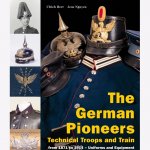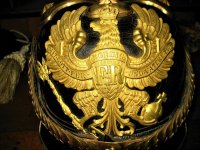SkipperJohn
Well-known member
This is my newest acquisition; a Prussian Train Battalion Officer's helmet:

The Train Battalions consisted of supply and logistics troops. They used horse drawn wagons to haul the three B’s necessary for an army to function (beans, bullets, and bandages). Though they used the railways for logistic functions they were not railway troops. Railway troops were attached to Engineer battalions at this time.

Enlisted Train troops wore a Tschako until 1903, but officers never did. They wore the Pickelhaube since the formation of the Train Battalions in 1853.

There is only one Kokarde on this helmet. The Reichskokarde was not adopted until 1897:

The Kokarde is made of leather with a metal ring. Perhaps a throwback to an earlier time:

The liner is the square tongue type used by officers until 1880:

The Wappen is a highly detailed stamping and retains it's original gilding:

This helmet could have been used in the Second Schleswig War, Prussia’s war with Denmark, 1 February 1864 to 30 October 1864; the Austro-Prussian War, Prussia’s war with the Austrian Empire, 14 June 1866 to 22 July 1866; and the Franco-Prussian War, 19 July 1870 to 28 January 1871.
Although a newer model helmet was implemented prior to the Franco-Prussian War, the Model 1867, these model 1860's may have been used in that conflict by veteran officers of earlier wars. Officers had to purchase their own equipment, so anyone becoming an officer after 1867 would likely purchase the newer version.

John

The Train Battalions consisted of supply and logistics troops. They used horse drawn wagons to haul the three B’s necessary for an army to function (beans, bullets, and bandages). Though they used the railways for logistic functions they were not railway troops. Railway troops were attached to Engineer battalions at this time.

Enlisted Train troops wore a Tschako until 1903, but officers never did. They wore the Pickelhaube since the formation of the Train Battalions in 1853.

There is only one Kokarde on this helmet. The Reichskokarde was not adopted until 1897:

The Kokarde is made of leather with a metal ring. Perhaps a throwback to an earlier time:

The liner is the square tongue type used by officers until 1880:

The Wappen is a highly detailed stamping and retains it's original gilding:

This helmet could have been used in the Second Schleswig War, Prussia’s war with Denmark, 1 February 1864 to 30 October 1864; the Austro-Prussian War, Prussia’s war with the Austrian Empire, 14 June 1866 to 22 July 1866; and the Franco-Prussian War, 19 July 1870 to 28 January 1871.
Although a newer model helmet was implemented prior to the Franco-Prussian War, the Model 1867, these model 1860's may have been used in that conflict by veteran officers of earlier wars. Officers had to purchase their own equipment, so anyone becoming an officer after 1867 would likely purchase the newer version.

John


